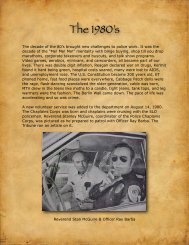Drainage Design Manual - the City of San Luis Obispo
Drainage Design Manual - the City of San Luis Obispo
Drainage Design Manual - the City of San Luis Obispo
You also want an ePaper? Increase the reach of your titles
YUMPU automatically turns print PDFs into web optimized ePapers that Google loves.
• A-Jacks are a potentially cost-effective alternative to rock rip-rap or o<strong>the</strong>r hard toeprotection techniques. They consist <strong>of</strong> a three dimensional star shaped structure (similarin shape to children’s jacks) constructed from concrete (Figure 6-9). Rows <strong>of</strong> A-Jacksare assembled to interlock in horizontal and vertical directions. Typically <strong>the</strong>y have apyramidal structure, with a base <strong>of</strong> three to four, or more units, decreasing in numberwith height. The voids in <strong>the</strong> matrix are back filled with soil and planted to nativeriparian trees and shrubs. Commonly 609-mm (24-inches) A-Jacks are used inmoderately sized streams, are toed in 0.3 to 6 meters (1 to 2 ft.), and rise in height from1.2 to 2 meters (4 to 7 feet). The 609- mm (24-inches) A-Jacks weigh 35 kilograms (78pounds) and can be constructed using hand labor or light equipment. Willow staking,willow wattling, erosion blankets, or o<strong>the</strong>r upper slope biotechnical approaches are wellsuited for use with A-Jacks. A-jacks do have aes<strong>the</strong>tic limitations that need to be takeninto consideration for use at some highly visible sites.• Traditional placed rock rip-rap consists simply <strong>of</strong> placement <strong>of</strong> rock on existingslopes. Often, this technique has been employed with little or no slope preparation, butgenerally a toe trench is constructed and key-ways are excavated into <strong>the</strong> bank at ei<strong>the</strong>rend <strong>of</strong> <strong>the</strong> revetment. When carefully constructed, rocks can be placed around obstaclessuch as trees. This technique requires careful selection and placement <strong>of</strong> rock material.This technique is not recommended for widespread usage in <strong>the</strong> SLO creek watershedbecause <strong>of</strong> concern over biological and geomorphic impacts.• Loose rock rip-rap consists simply <strong>of</strong> placement <strong>of</strong> rock on existing slopes grades withlittle or no slope preparation. Generally a toe structure is not constructed. The advantage<strong>of</strong> this method is that rocks can be placed around obstacles such as trees. Thedisadvantage is that <strong>the</strong> finished embankment is not as stable as a properly engineeredand constructed slope, because <strong>of</strong> <strong>the</strong> possible lack <strong>of</strong> toe support and <strong>the</strong> fact thatfrequently <strong>the</strong> slopes are steep, to 1H:1V. Sometimes pipes are driven into <strong>the</strong> toe <strong>of</strong> <strong>the</strong>channel to provide support for <strong>the</strong> loser rack. This technique requires careful selectionand placement <strong>of</strong> rock material. As with planted rock rip-rap, live willow stakes can beinserted in voids between rocks. Loose rock can <strong>of</strong>ten be used as a transition structureupstream and downstream from <strong>the</strong> main bank protection element.• Concrete block walls can be constructed in a variety <strong>of</strong> ways, including reinforcedmortared cinder blocks, stacked slab concrete, concrete or cinder blocks with open rearfaces that are set on top <strong>of</strong> each o<strong>the</strong>r at slight incline and filled with soil (i.e., Keystoneblock walls), or larger concrete bins that are backfilled with soil and have <strong>the</strong>ir front edgeplanted with vines. These walls provide good shear resistance and slope support, and canbe designed to be somewhat flexible, however <strong>the</strong>y deflect flows more than most <strong>of</strong> <strong>the</strong>o<strong>the</strong>r techniques listed here, and are very difficult to completely vegetate and disguise.This technique has very limited applicability in <strong>the</strong> SLO Creek watershed forenvironmental reasons, but could be considered where top <strong>of</strong> bank land constraints andchannel capacity limitations require near vertical walls be used.SLO Creek <strong>Drainage</strong> <strong>Design</strong> <strong>Manual</strong> 73 February 2003
















